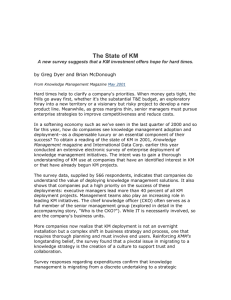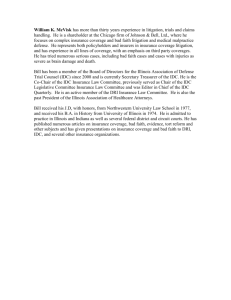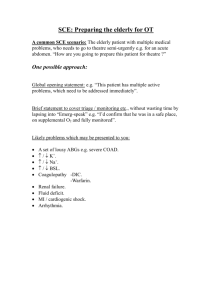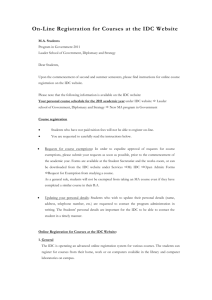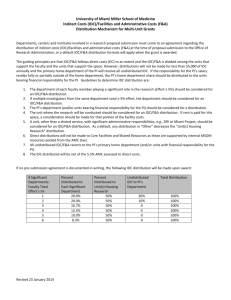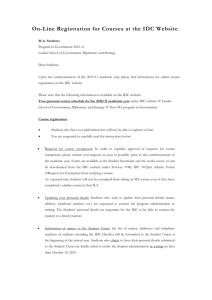Organizational Blind Spot: The Role of Document
advertisement
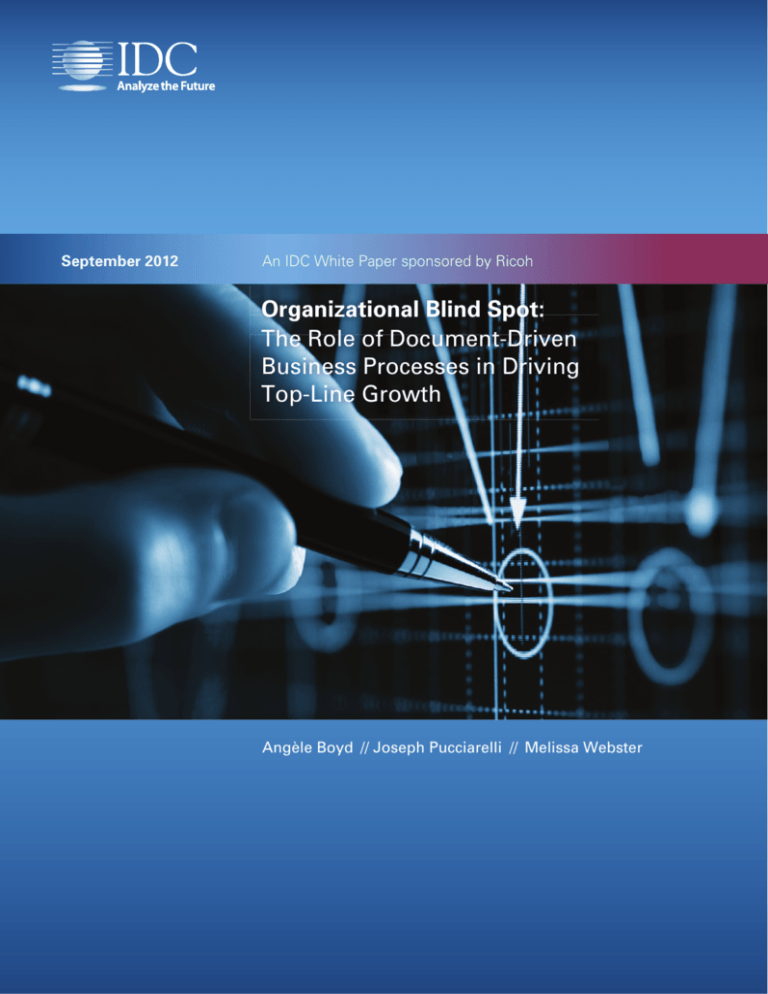
September 2012 An IDC White Paper sponsored by Ricoh Organizational Blind Spot: The Role of Document-Driven Business Processes in Driving Top-Line Growth Angèle Boyd // Joseph Pucciarelli // Melissa Webster Contents: Executive Summary . . . . . . . . . . . . . . . . . . . 2 Essential Guidance. . . . . . . . . . . . . . . . . . . . 3 Improving Document Processes Yields Strategic, Top-Line Benefits. . . . . . . . . . 4 Improve Revenue an Average of 10%. . . . . . . 5 Reduce Risk of Losing Customers. . . . . . . . . 6 Speed Time to Market by up to 13.4% . . . . . . 7 Ineffective Document Processes in Supply Chain Are Costly . . . . . . . . . . . . . . . 8 Intersection of Tablets and Document Processes Is Critical But Ill-Defined . . . . . . . . . 9 Still Room for Cost Takeout . . . . . . . . . . . . . . 10 Appendix . . . . . . . . . . . . . . . . . . . . . . . . 11 Executive Summary Findings from a recent IDC study indicate that documentdriven processes — the business processes that are governed and controlled by documents in electronic or paper format — have a profound impact on companies’ customer-facing functions. Furthermore, reengineering these document processes can yield strategic, top-line benefits including revenue growth and improved market responsiveness, which this study found to be the highestrated business priorities for enterprises today. Despite the belief held by many business executives that documentdriven processes relate only to “back office” functions, IDC research indicates that this conventional wisdom is off the mark and that optimizing document-driven processes presents a significant revenue growth opportunity. IDC’s recent global study of 1,516 document-driven business process owners and information workers suggests that common perceptions around document-driven business processes are mistaken. Businesses have placed a great degree of focus on improving their business processes, and many may believe they have achieved optimum efficiency in their document-driven processes. While it is true that improving document-driven processes can have a strong impact on reducing operational costs — and this study shows there is still room for improvement in this area — it can have an even greater impact on an organization’s top-line potential for revenue. Specifically: • Over 83% of study respondents indicated that optimizing customer-facing document-driven business processes would increase revenue — on average by 10.1%. This could be achieved by improving customer communications, streamlining the sales and customer onboarding process, and improving customer support. • In their role as consumers, more than half of the respondents are dissatisfied with the document-driven processes in six of the seven industries studied: business services (64.9%), government (63.9%), healthcare (63.1%), education (62.3%), insurance (54.3%), and telecommunications (51.8%). • Among consumers who are dissatisfied with companies’ document processes, 60.1% would switch to another provider and 56.8% would likely tell others about their dissatisfaction. • Respondents estimated that they could speed the time to get products to market by 13.4% by streamlining new product development, manufacturing, and supply chain functions. Busted Myth: The impact of improving document-driven business processes applies only to reducing costs through back-office efficiencies. IDC Finding: Over 83% of study respondents found that optimizing document-driven business processes would increase revenue on average by 10.1% and could speed time to market by 13.4%. Document-driven business processes have a strong impact on strategic, top-line growth objectives. Business partners — suppliers and distributors — play a key role in today’s economy, and the health of their document processes directly affects the enterprise. More than 75% of study participants believe it is important that their supply-side and distribution-side partners have effective document processes, but only about half are satisfied with the state of their partners’ processes. Enterprises must work to ensure that the partners they select are placing appropriate emphasis on documentdriven business processes. 2 The introduction of tablets into the enterprise is part of a new wave of enterprise computing. It is improving employee productivity and allowing organizations to more rapidly address market needs, but at the same time it is dramatically changing the way employees interact with document-driven business processes. The intersection of tablets and document-driven processes is still not clearly defined or fully understood. Many organizations are aware of the importance of making existing document processes work with tablets, with one in three organizations currently investing to reengineer existing document processes to account for them. But to make all necessary processes fully tablet compatible, organizations need to increase their focus on this area. Conventional wisdom has clearly missed the key point. Document-driven business processes are not just a back-office phenomenon; they are critically important for strategic, revenue-generating activities. Process improvements can both reduce costs and increase revenue — a win-win scenario. This is one of those rare areas where there is no downside to investing in improvements. Organizations that do not place a high priority on improving their document processes are missing a golden opportunity, but companies need to focus executive-level attention and take action — now. Improving document-driven processes increases top-line revenue and reduces bottom-line costs — a win-win. There is no downside to investment, but companies need to act now. Essential Guidance Document-driven processes are critical information arteries that drive organizations’ financial results — both top line and bottom line. They facilitate information flows throughout an organization, between an organization and its business partners, and between an organization and its customers. Customers and partners care about them, and process owners and information workers depend upon them. Given the systemic impact of document-driven business processes on organizational outcomes, IDC believes that these processes merit significantly more C-level executive time and attention than they currently receive. Survey participants agree: Over 40% believe that investments to improve document processes should receive higher priority than other similar investments. In addition, as the pace of business continues to accelerate, the economic stakes associated with these business processes continue to escalate. IDC believes that many businesses are now at or near the bottom of the cost reduction trough. These businesses are now seeking opportunities to improve market share and better position themselves when the global economy resumes sustainable growth. Given this environment, IDC offers the following guidance: Focus on document-driven processes for strategic upside. … These changes can help improve customer-facing potential and reduce overall operating costs. • Focus on document-driven processes for strategic upside. There is little downside to optimizing customerfacing processes. Many strategic initiatives focus strictly on cost, while other initiatives aim to yield strategic benefits. Optimizing document-driven business processes is the rare initiative that achieves both goals: Companies can improve efficiency and benefit from the strategic upside by improving customer relationships — it is a no-lose scenario. • Recognize that ineffective document processes damage customer relationships and hence your company. Some executives may believe that their document-driven business processes do not play a customer-facing role. One should not fall victim to this perception. This study found the opposite is true. Customers believe it is important that the companies they do business with have efficient and effective document processes, and many are dissatisfied with the state of the processes of those companies. Dissatisfied customers will take their business elsewhere, will tell others not to do business with the companies, and will post negative reviews of the companies. 3 • Take an extended view of document processes to include supply chain and distribution partners. In the modern economy, it is no longer adequate to take a traditional wall-to-wall approach. Business processes now stretch across continents and often require intimate connections with business partners and suppliers throughout the value chain. Addressing the effectiveness and efficiency of suppliers’ and distributors’ document-driven processes is critical for global enterprises to maximize business results. • Prepare your enterprise for tablet usage to avoid putting new stresses on document processes. Tablets have already made significant inroads into organizations, and in the future, their penetration will only increase. But the intersection of tablets and document-driven business processes is not clearly defined. There is a significant and growing requirement among businesses to integrate tablets into existing document-driven business processes. New requirements in document management include the need to scan to cloud and the need to address security issues around tablet printing both inside and outside the firewall. • Make document process repair a high priority for C-level executives. C-level executives are extremely busy and must constantly balance competing interests and priorities. But the optimization of document processes needs to be among those priorities. Previously published results from this study demonstrate that addressing issues in document processes is not receiving a significant amount of C-level attention, with about 80% of organizations delegating responsibility for it under the C-level. But only C-level executives have the authority and span of control to implement appropriate change, and C-level executives uniquely have responsibility for both revenue-generating and cost-cutting initiatives. Fixing document processes should be the responsibility of C-level executives. Addressing issues in document-driven processes is one of those rare areas where there is no downside to investing in improvements. These changes improve an organization’s customer-facing potential and enable cost savings. It is an item that every organization should actively consider and an item that should be at the top of most C-level executives’ to-do lists. Improving Document Processes Yields Strategic, Top-Line Benefits Document-driven business processes are vital organizational information arteries, governing a wide range of functions in nearly every corner of the enterprise. This research found that over 40% of all business activities rely on the information (often unstructured) that is captured in documents and that between 31% and 39% of these processes continue to rely on paper, depending on the type of process. “We live on the paperwork and the documentation for so many different aspects of the business.” — VP, HR of Multinational Import/Export Firm Results from the survey clearly speak to the importance of optimized document processes. 84.1% of respondents rated effective and efficient document processes as “very important” to business success. Only 1.9% said that these processes are “not important” (see Figure 1). Figure 1: Effective/Efficient Document-Driven Processes Are Very Important to Business Success Not important 1.9% Neutral 14.0% Very important 84.1% Q2. Overall, given where you sit in your organization, how important are effective and efficient document-driven business processes to the overall success of your business? n = 1,516 Source: IDC’s Document Management Thought Leadership Survey, February 2012 4 Fixing document-driven business processes has meaningful economic upside, starting with revenue-generating, customer-facing issues. Given that critical customer-facing processes — including sales and marketing, customer communications, customer onboarding, service and support, developing new products, and billing and collection — are highly dependent on documents for smooth operation, breakdowns in these processes can have a direct impact on revenue and customers. Respondents agree: 77.6% said that improving these processes would help them more rapidly address customer needs, 65.0% said it would help them more rapidly respond to changes in the market, and 62.7% said it would improve their competitive stance (see Figure 2). Figure 2: Fixing Customer-Facing Processes Helps Address Customer Needs, Improve Competitive Stance, and Improve Revenue Would allow us to better or more rapidly address customer needs . . . 77.6% Would allow us to more rapidly respond to changes in market . . . . . . 65.0% Would improve our competitive stance or differentiation . . . . . . . 62.7% 0% 10% 20% 30% 40% 50% 60% 70% 80% % of respondents who agree/strongly agree Q13. If you could wave a magic wand and fix all the issues in effectiveness and efficiency in your customer-facing document-driven business processes, what overall effect do you believe it would have on your organization? n = 1,112 Source: IDC’s Document Management Thought Leadership Survey, February 2012 Over 83% of Survey Respondents Reported That Optimizing Customer-Facing Document-Driven Processes Can Improve Revenue by an Average of 10% Respondents were asked about the degree to which fixing their customer-facing document-driven processes would improve revenue to their business, and the results were striking. 83.2% of respondents believe that there would be a positive impact on revenue (see Figure 3) because companies would streamline business functions that enable them to effectively get their products and services to market and provide superior service to customers once they are on board. These processes include sales, customer communications, customer onboarding, customer service, and new product development. Also included are industryspecific processes such as insurance/claims processing in the insurance business and patient medical records in the healthcare industry. Figure 3: Over 83% of Respondents Believe Optimizing Customer-Facing Processes Would Improve Revenue Reduce revenue 1.6% No effect 15.3% Increase revenue 83.2% Q14. If you waved that magic wand and fixed all the issues in effectiveness and efficiency in your customer-facing document-driven business processes, what effect would it have on your organization’s overall revenue? n = 1,100 Source: IDC’s Document Management Thought Leadership Survey, February 2012 The survey also asked respondents to estimate the revenue impact of optimized customer-facing document processes. 24.3% of respondents — the largest grouping — estimated that optimizing these processes would lead to a 6–10% improvement in revenue, and 28.0% estimated it would improve revenue by over 10%. When we averaged the responses together, we found that respondents expect optimized customer-facing document processes to increase revenue by 10.1% (see Figure 4). A 10.1% revenue improvement is a dramatic potential increase. In today’s economy, many businesses are facing sluggish market growth and are challenged to find ways to expand their top-line revenue growth. If they can achieve 10% growth simply through improving the level of service, communication, and support to their customers by optimizing customer-facing document processes, this has the potential to be a huge win. For a hypothetical organization with $1 billion in annual revenue operating at a 70% gross margin, a 10.1% top-line revenue increase would yield a bottom-line improvement of more than $70 million. “If we’ve got dissatisfied clients, that’s a bottom-line hit.” – VP, Strategic Planning, Large Insurance Company 5 Figure 4: Average Expected Revenue Improvement Is 10.1% Average increase: 10.1% Increase by more than 50% . . . . . . . . . . . . . . . . . . . . . . . . . . . . . . . . 2.4% Increase by 36–50% . . . . . . . . . . . . . . . . . . . . . . . . . . . . . . . 3.6% Increase by 21–35% . . . . . . . . . . . . . . . . . . . . . . . 9.9% Increase by 11–20% . . . . . . . . . . . . . . . . . . . 12.3% Increase by 6–10% 24.3% Increase by 3–5% . . . . . . . 19.3% Increase by up to 2% . . . . . . . . . . . . . . . . . . . 11.5% No effect . . . . . . . . . . . . . . . 15.3% Reduce revenue . . . . . . . . . . . . . . . . . . . . . . . . . . . . . . . . . . . 1.6% 0% 5% 10% % of respondents 15% 20% other business services. In government filings, documents are used to manage virtually all aspects of constituent relationships, and broken processes can have a severe impact. In the healthcare segment, where providers use documents for a wide variety of purposes, including admissions and patient care management, filing claims, and handling billing and collections, 63.1% of respondents reported that they are dissatisfied. Similarly, the education, insurance, telecommunications, and banking industries are dependent on document-driven processes for a wide variety of customer-facing activities. When document-driven business processes break down, and these findings show they often do, customers feel the sting. Figure 5: Consumers Are Dissatisfied with Document Processes at Key Service Providers such as Legal Firms, Government Agencies, and Healthcare Providers 25% Q14. If you waved that magic wand and fixed all the issues in effectiveness and efficiency in your customer-facing document-driven business processes, what effect would it have on your organization’s overall revenue? n = 1,100 Source: IDC’s Document Management Thought Leadership Survey, February 2012 Ineffective Business Processes Significantly Increase Risk of Losing Customers One of the major ways that ineffective document processes can affect revenue is through the risk of losing customers. In our survey, 72.6% of respondents said that it is important to them as consumers that the companies they do business with have efficient document-driven business processes. Unfortunately, on average across the seven industries studied, 57.9% of respondents said that they are not completely satisfied with the document-driven processes in the companies and organizations they interact with (see Figure 5). The degree of dissatisfaction expressed by respondents is surprising. Business services are dependent on customerfacing processes for a wide variety of activities, yet they appear to fall wide of the mark with most customers. For example, in the legal field — the industry segment with the most dissatisfaction (64.9%) — wills, divorce filings, and small customer claims are highly dependent on document processes, as are accounting services, tax preparation, and Business services (legal: wills, divorces, small claims; tax preparation...) . . . 64.9% Government (filing taxes, auto registration, voter registration…) . . 63.9% Healthcare providers (admissions, filing claims, billing and collections...) . . 63.1% Education (applying to schools or financial aid, paying tuition, checking and receiving grades...) . . . . 62.3% Insurance (establishing a policy, filing a claim...) . . . . . . . . 54.3% Telecommunications and utilities (paying bills, changing plans, disputes resolution...) . . . . . . . . . 51.8% Banking/financial institutions (credit card, loan approvals, establishing an account...) . . . . . . . . . . . . 45.2% 0% 10% 20% 30% 40% 50% 60% 70% 80% % of respondents who are not satisfied with the process Q50. As a consumer, what is your level of satisfaction with the document-driven business processes you have come into contact with over the past 18 months? n = 1,516 Source: IDC’s Document Management Thought Leadership Survey, February 2012 Unfortunately for businesses, the fallout from broken customer-facing processes can be quite dramatic. Acquiring a new customer is usually more difficult and expensive than retaining an existing customer; however, based on these research findings, it appears that inefficient and ineffective document processes are actively driving customers to 6 other providers. Respondents said that they would shift to another provider if they encountered issues with document-driven processes: 68.7% said that they would be less likely to do business with offending companies in the future, while 60.1% said that they would take their business elsewhere. Further, 56.8% said that they would tell others not to do business with these companies (see Figure 6). Each of these outcomes can have materially negative consequences. When measuring customer experience, most providers generally strive for customer experience satisfaction levels above 95%. In contrast, the level of dissatisfaction with document processes observed in this study can be observed in Figure 6. Over 6 in 10 respondents said that they will switch providers and avoid doing business with them in the future. Figure 6: Consumers Will Defect When Companies’ Document Processes Are Deficient I am less likely to do business with them in the future 68.7% I am likely to switch to a different company or provider . . . . 60.1% I am likely to call their customer service line and/or go online to obtain support . . . . . 57.0% I am likely to tell others not to do business with them in the future . . . . . 56.8% I am likely to write negative reviews of them on online forums . . . . . . . . . . . . . . . . . 34.5% 0% 10% 20% 30% 40% 50% 60% 70% 80% % of respondents who agree/strongly agree Q51. As a consumer, what is the impact of companies’ inefficient or ineffective business processes on your willingness to do business with them? n = 1,516 Source: IDC’s Document Management Thought Leadership Survey, February 2012 In today’s competitive and hypersocial marketplace, customers have at their disposal a much more efficient platform to share their dissatisfaction, with many options to negatively impact the reputation of companies with which they are dissatisfied. Customers regularly share their experiences and provide feedback to companies and peers on online social media, and with bad word of mouth being passed along to eight people compared to good word of mouth passed along to only three, the negative customer consequences can compound. The finding in this study that more than 83% of survey respondents reported that improved document-driven business processes would increase revenue may seem counterintuitive to some readers — especially readers who believe that their organizations do a reasonable job of managing their organization’s processes. The findings highlighted in Figures 5 and 6 paint an unpleasant picture — one of dysfunctional organizations with dissatisfied customers readily sharing information about their unhappiness. Anyone resisting the idea that documentdriven processes could positively affect business outcomes should contrast that point of view with these blunt findings. According to the survey respondents, the documentdriven processes in many organizations are a source of underlying customer friction and dissatisfaction — which is undoubtedly affecting broader business outcomes. Busted Myth: Customers don’t feel the effect of broken document-driven business processes. IDC Finding: Less than half of consumers — 42.1% — are happy with the document-driven business processes of companies in a variety of industries: Of those consumers, 60.1% would switch to another provider and 56.8% would tell others of their dissatisfaction. Improving Customer-Facing Processes Can Speed Time to Market by up to 13.4% This study shows that document-driven business processes are important to an organization’s revenue, but they can have an even bigger impact on time to market (see Figure 7). 90.5% of respondents believe that fixing customer-facing document processes would speed time to market, with 20.8% believing it would yield a 6–10% improvement and 40.4% stating it would speed time to market by over 10%. On average, respondents believe that optimizing customer-facing document processes would speed time to market by 13.4%. For businesses in many industries, time to market is critical, and being a leader or a laggard in bringing innovations to market can be the difference between success and failure. Improving time to market by 13% can be a powerful source of competitive differentiation and a lasting means of gaining competitive advantage. 7 Figure 7: Fixing Customer-Facing Document Processes Can Speed Time to Market by 13.4% Average improvement: 13.4% Speed by more than 50% . . . . . . . . . . . . . . . . . . . . . . . . . . . . . 4.2% Speed by 36–50% . . . . . . . . . . . . . . . . . . . . . . . . . . . . 6.3% Speed by 21–35% . . . . . . . . . . . . . . . . . . . . . . . 12.6% Speed by 11–20% . . . . . . . . . . . . . . . . . . . 17.2% Speed by 6–10% 20.8% Speed by 3–5% . . . . . . . 16.9% Speed by up to 2% . . . . . . . . . . . . . . . . . . . 12.5% No effect . . . . . . . . . . . . . . . . . . . 8.6% Slow ability to address customer needs . . . . . . . . . . . . . . . . . . . . . . . . . . . . . 0.9% 0% 5% 10% % of respondents 15% 20% 25% Q16a. If you waved that magic wand and fixed all the issues in effectiveness and efficiency in your customer-facing document-driven business processes, what effect would it have on your ability to address customer needs or respond to changes in the market? n = 1,100 Source: IDC’s Document Management Thought Leadership Survey, February 2012 Ineffective Document Processes in Organizations’ Supply Chains and Distribution Channels Are Costly Another area of potential disruption to document-driven process efficiency and effectiveness is the company supply chain. As companies recover from the global economic downturn, they have three fundamental options to scale: hire more staff, improve the productivity of existing staff, or partner with strategic vendors and suppliers. Given the nature of this lean recovery, companies have avoided hiring new staff, and many have already run up against the limits of productivity they can squeeze out of their overstretched workforces. In contrast, reliance on partners has continued to rise, which also allows companies’ internal staff to focus on higher-value activities while outsourcing everything that doesn’t fit into their own core competency. It also allows companies to scale in a flexible way. “Sometimes — because you’re dealing with a third party — when a mistake is made, it takes a long time to correct.” — GM, Hotel Chain But risks are associated with this trend. As companies outsource more operations, they become more dependent on those partners’ document-driven processes. IDC believes it is critical to select and manage partners to ensure effective document processes in one’s supply chain and distribution channels. Survey respondents agree: 75.8% of respondents think it is important that supply-side partners have effective and efficient document processes, and 76.5% think it is important that distribution-side partners have effective and efficient document processes. Unfortunately, many respondents also see deficiencies in their partners’ document-driven business processes. 45.4%, or nearly half, of respondents believe that their suppliers’ processes are not fully efficient or effective, and 43.1% are not fully satisfied with the processes of their distributionside partners (see Figure 8). Busted Myth: The impact of documentdriven business processes ends at the enterprise boundary. IDC Finding: Nearly half of enterprises think that their partners’ document-driven business processes are broken (45.4% for suppliers and 43.1% for distributors), and over half said that partners’ ineffective processes increase costs (56.9%) and reduce their organization’s business agility (53.9%). Figure 8: Partners’ Document Processes Are Often Inefficient or Ineffective Suppliers, services providers, other vendors Distributors, resellers, other channel partners 45.4% . . 43.1% 0% 10% 20% 30% 40% 50% % of respondents who are not satisfied with partners’ document processes Q43/46. How would you characterize the level of effectiveness and efficiency of the document-driven business processes of your [supply-side partners (suppliers, services providers, or other vendors)/distributionside partners (distributors, resellers, channel partners)]? Are their processes ineffective or inefficient? n = 594 for supply-side partners, n = 500 for distribution-side partners Source: IDC’s Document Management Thought Leadership Survey, February 2012 8 Broken processes in strategic partners are costly: 56.9% of respondents said that inefficient or ineffective partner document-driven processes increase operational costs. In addition, more than half of respondents said that such processes reduce their ability to respond quickly to changes in the marketplace and impair overall business agility (see Figure 9). The lesson is clear that outsourcing any process that is broken simply results in an outsourced mess. Figure 9: Inefficient/Ineffective Partner Processes Negatively Impact the Business Increases our operational costs 56.9% Reduces our organization’s ability to respond quickly to changes in the marketplace . 55.4% Reduces our organization’s business agility . . 53.9% Increases our organization’s information security risk . . . . . 49.0% Increases our organization’s regulatory compliance risk . . . . . . 46.8% 0% 10% 20% 30% 40% 50% 60% % of respondents who agree/strongly agree Q48. What is the impact on your organization when your business partners have inefficient or ineffective document-driven business processes? n = 1,516 Source: IDC’s Document Management Thought Leadership Survey, February 2012 Intersection of Tablets and Document Processes Is Critical But Ill-Defined Despite the recognized importance of effective and efficient document-driven processes, potential disruption looms in the form of the media tablet. Media tablets are making inroads into the enterprise at rates that many would have considered unthinkable only two years ago, before the first tablet was even released to the general market. The rapid pace of adoption is evidenced by the study, in which fully 17.7% of employees said that they are currently using tablets to support customer-facing document-driven processes and 17.6% of employees are using them for non-customer-facing document-driven processes (see Figure 10). Figure 10: Rising Adoption of Tablets in the Enterprise Use tablets for customer-facing processes — today . . . . . 17.7% Use tablets for non-customer-facing processes — today . . . . . . 17.6% Will use tablets for work-related activities — next 12–18 months 20.7% 0% 5% 10% 15% 20% 25% % of respondents who agree/strongly agree Q26/27/28. What percentage of employees use [tablets] for customerfacing document-driven business processes? What percentage of employees use tablets for non-customer-facing document-driven business processes? Over the next 12–18 months, what percentage of your organization’s employees do you think will use tablets for business purposes? n = 1,516 Source: IDC’s Document Management Thought Leadership Survey, February 2012 The adoption of tablets in the enterprise corresponds to what IDC sees as part of the next wave of enterprise computing and the next transformative moment for CIOs. Just as PCs redefined mainframe computing in the 1980s and the Internet redefined client/server computing in the 1990s, today, cloud, big data, mobility (including tablets), and social business are redefining the way employees interact with applications and, by extension, with customers, suppliers, and coworkers. This finding was borne out by the study. While many executives believe the adoption of tablets has reduced the number of pages printed in their enterprise (59.2% of survey respondents believe tablets reduce the number of printed pages), what is more striking is the strategic role tablets are playing in the organization, with 49.2% of respondents saying tablets would enable their organization to more rapidly address customer needs and 47.5% saying tablets would improve the speed at which document processes operate (see Figure 11). “An outsourcing arrangement has to be governed. I think we have something like 26 different governance processes just to deal with the outsourced provider, and it’s very document driven.” — VP, Global IT, Large Cosmetics Manufacturer 9 Figure 11: Tablets Have Strategic Impact Would allow us to better or more rapidly address customer needs 49.2% Would improve the speed at which document-driven business processes operate . . . . . . . . 47.5% Would allow us to more rapidly respond to changes in the market . . . . . . . . . . . . . . . 33.6% Would reduce our overall operational costs . . . . . . . . . . . . . . . . . . . . 32.3% Would improve our competitive stance or differentiation . . . . . . . . . . . . . . . . . . . . . . . . . 29.5% Would increase our overall revenue . . . . . . . . . . . . . . . . . . . . . . . . 19.7% Would reduce business and/or compliance risk . . . . . . . . . . . . . . . . . . . . . . . . 19.7% Would reduce business continuity risk . . . . . . . . . . . . . . . . . . . . . . . . 19.5% 0% 10% 20% 30% 40% 50% 60% % of respondents who agree with the benefits Q30. Over the next 12–18 months, if and when employees begin using tablets for business purposes, which, if any, of the following benefits do you expect they will bring? n = 1,516 Source: IDC’s Document Management Thought Leadership Survey, February 2012 But many organizations are not prepared for the changes that tablets will introduce to document processes. IDC believes that tablets will increase friction in the enterprise and its document processes until organizations deal with the impact of tablets. The study shows that over 30% of processes still rely on paper, and many more processes flip back and forth from paper to electronic. With fewer defined routes to move documents from electronic to paper and vice versa via tablets (e.g., with fewer tablet-based scanning and printing options), the use of tablets in document processes is introducing new roadblocks and issues. Busted Myth: Tablets have relatively little impact on document-driven business processes. IDC Finding: Tablets are playing a profound strategic role in document-driven processes, and there is a significant need to ensure the two play well together. For many enterprises, the intersection of tablets and document-driven business processes is not clearly defined, and there is a significant need among businesses to ensure that tablets play well with document-driven processes. Reflecting the importance of this issue, 33% of organizations in this survey have initiatives under way to adapt their processes for use with tablets. IDC believes enterprises will need to continue to invest to adapt their processes for use with tablets and will need to continue to roll out these reengineering efforts to all critical documentdriven processes that involve tablets. Opportunities for improvement include the need to scan to cloud and print from tablets and the need to address security issues around tablet printing both inside and outside the firewall, all while providing a seamless user experience and conforming to necessary organizational compliance guidelines. The Bottom-Line Benefits Compound: Top-Line Revenue Growth with Still More Room for Cost Takeout Of course, the benefits of addressing inefficiencies in document-driven processes go beyond improving top-line revenue. Common wisdom is correct that documents drive many back-office, non-customer-facing processes ranging from demand planning and supply chain management to asset management, IT/infrastructure support, legal, and HR processes. But while many organizations may believe they have already driven maximum efficiency into these processes, this survey found that there is plenty of room for improvement. Fully 86.6% of respondents believe that addressing inefficiencies in non-customer-facing processes would allow them to reduce their operating costs, with 22.2% estimating it would reduce operating costs by 3–5% and 23.4% judging it would reduce operating costs by more than 10%. On average, respondents estimated it could reduce their overall operating costs by 8.3% (see Figure 12). These benefits compound — they accrue in addition to the top-line revenue increase achievable by addressing customer-facing document processes. The same hypothetical organization discussed previously in the paper — with $1 billion in annual revenue and a 70% gross margin — would potentially achieve $58.1 million in operational cost savings, on top of the $70.7 million in gross margin contribution from an improved top line — a total improvement of $128.8 million to the bottom line. 10 Figure 12: Fixing Non-Customer-Facing Document Processes Can Reduce Costs by 8.3% Average reduction: 8.3% Reduce by more than 50% . . . . . . . . . . . . . . . . . . . . . . . . . . . . . . . . 1.1% Reduce by 36–50% . . . . . . . . . . . . . . . . . . . . . . . . . . . . . . . 2.9% Reduce by 21–35% . . . . . . . . . . . . . . . . . . . . . . . 6.6% Reduce by 11–20% . . . . . . . . . . . . . . . . . . . 12.9% Reduce by 6–10% . . 21.1% Reduce by 3–5% . . . . . . . 22.2% Reduce by up to 2% . . . . . . . . . . . . . . . . . . . 19.9% No effect . . . . . . . . . . . . . . . 11.4% Increase operational costs . . . . . . . . . . . . . . . . . . . . . . . . . . . . . . . 2.0% 0% 5% 10% 15% 20% 25% % of respondents Q22. If you waved that magic wand and fixed all the issues in effectiveness and efficiency in your non-customer-facing document-driven business processes, what effect would it have on your organization’s overall operational costs? n = 1,067 Source: IDC’s Document Management Thought Leadership Survey, February 2012 Again, IDC is struck by the magnitude of this finding. Over the past two to three decades, driven by examples in Six Sigma manufacturing, enterprises in industries around the world have focused on improving efficiencies in processes centered on factories and supply chains. Many organizations have optimized those processes to the extent that they are now struggling to squeeze some improvement out of them. In contrast, this survey shows not only that efficiencies can be gained in a much wider range of non-customer-facing processes but also that fixing these processes can yield significant bottom-line benefits. Busted Myth: Organizations have already achieved all available cost takeout from improving document-driven business processes. IDC Finding: 86.6% of respondents said that costs can be further reduced and that full optimization of documentdriven processes could achieve overall operational cost savings of 8.3%. Appendix IDC Study Methodology The information for this white paper came from a global survey plus two focus groups of U.S. executives, all of which were conducted in 4Q11. IDC surveyed 1,516 process owners and information workers from IT, finance, and line-of-business management from organizations of over 500 employees. These individuals all had responsibility for business processes that required multiple documents. Respondents were randomly recruited and screened from international panels and came from eight countries: the United States, Canada, the United Kingdom, France, Germany, Australia, China, and Japan. Global data was derived by weighting the IT executive survey by country GDP. The survey was conducted over the Internet and administered in the local language. All numbers in this document may not be exact due to rounding. Respondents were asked about priorities, issues, and investments across 23 separate business processes: customer onboarding, sales, new product development, customer service, marketing/customer communication, insurance/ claims processing, billing and collection, HR (employee onboarding, benefits, dismissals), demand planning, manufacturing (shop floor, inventory), distribution channel management, vendor/supply chain management, engineering/R&D, legal (contracts, litigation), medical (patient medical records), IT infrastructure/ desktop support, financial planning and reporting, asset management, business continuity/risk assessment, compliance/audits, change/problem management, business monitoring and controls, and information security. Data was gathered both at the individual process level and in three higher-level rollups: customer-facing, non-customerfacing, and risk mitigation processes. This survey was supplemented by two focus groups of U.S. executives. One group consisted of line-of-business executives, and the other consisted of IT and finance executives. The individuals in both groups had oversight of or control over a variety of document-driven business processes for their organizations. Respondents were drawn from organizations with over $1 billion in revenue and from a range of industries. Representative titles included VP Strategic Planning, VP Sales, General Manager, VP 11 Global Marketing, Chief Security Officer, VP Global Resources, Senior VP Technology Planning, VP Global IT, Corporate VP Finance Technology, and VP/Treasurer. Participant Screeners The following screening questions were applied to target respondents: Definitions The following definitions were used for this study: S6. Are you involved in, or do you have oversight of, any document-driven business processes for your organization? (Examples might include sales order processing, customer onboarding, customer communications or correspondence, customer service and support, billing and collections, and new product development.) • Document-driven business processes are performed by one or more groups within the organization and are governed or driven by information captured in documents. Documents can be paper (printed, scanned, or entirely paper based) or electronic, or they can migrate between paper and electronic during the end-to-end life cycle of the business process. The term is also shortened to “document-driven processes” or “document processes” in places. • Customer-facing business processes govern customerfacing activities including sales, customer onboarding, customer communications, customer service and support, billing and collections, and new product development. • Non-customer-facing business processes govern non-customer-facing activities including employee onboarding, demand planning, manufacturing, purchasing and vendor management, desktop support, business continuity, audits, and financial controls. • Compliance and risk mitigation or management processes cover activities including business continuity, compliance, auditing, customer due diligence, change/ problem management, risk assessment, remote business monitoring, and information security. Related Research This white paper is the second of two white papers based on IDC’s global Document Management Thought Leadership Survey published in February 2012. The first paper, “It’s Worse than You Think: Poor Document Processes Lead to Significant Business Risk” (IDC white paper #6352, June 2012), explores the relationship between inefficient and ineffective document-driven business processes and business risk, describes how 75.9% of respondents have experienced serious business risk and/or compliance issues as a direct result of broken document processes, and explores some of the business drivers and ramifications. S7. Which of the following document-driven business processes are you involved in or do you have oversight of ? [Check all that apply] Dark Blue = Customer-Facing Processes Blue = Non-Customer-Facing Processes Red = Risk Mitigation Processes a. Customer onboarding b.Sales c. New product development d. Customer service e. Marketing/customer communication f. Insurance/claims processing g. Billing and collection h. HR (employee onboarding, benefits, dismissals) i. Demand planning j. Manufacturing (shop floor, inventory) k. Distribution channel management l. Vendor/supply chain management m.Engineering/R&D n. Legal (contracts, litigation, etc.) o. Medical (patient medical records, etc.) p. IT infrastructure/desktop support q. Financial planning and reporting r. Asset management s. Business continuity/risk assessment t.Compliance/audits u. Change/problem management v. Business monitoring and controls w. Information security S8. Are you responsible for owning/implementing/managing any of these document-driven business processes? S9. For each of the document-driven business processes you have visibility into and insight over in your business, what percentage of the documents would you say are paper (as opposed to electronic)? 12 About the Authors Angèle Boyd — Group Vice President, General Manager, Imaging/Output Document Solutions & SMB. Angèle is responsible for IDC’s worldwide research practice in the areas of imaging, output, and document solutions (printing, scanning, business-critical document workflows, and managed print/document services). She is also responsible for IDC’s U.S. small/medium-sized business research spanning the IT industry. She has conducted research and consulting at IDC since 1986. During this time, she has been recognized as a Chairman’s Achiever, and she has received the company’s award for research excellence, the James Peacock Award. Joseph Pucciarelli — Vice President & IT Executive Advisor for IDC’s IT Executive Programs. As an IT executive advisor, Joseph uses his 20-plus years of business and technology experience to provide ongoing insight and guidance to business and technology executives seeking to leverage the critical technologies of cloud computing, mobility, social business, and big data/analytics that have begun transforming both business and consumer technology usage and interaction models. His research is published in IDC’s CIO Agenda and IT Cloud Decision Economics research programs, and he also contributes to an ongoing series of in-depth special research reports on a range of technology management issues. A noted analyst with broad business experience in the financing and technology industries, Joseph has held a variety of consulting, product marketing, risk management, and senior management positions with companies including Gartner, GE Capital, Peregrine Systems, and his own company, Strategance. Melissa Webster —Program Vice President, Content and Digital Media Technologies. Melissa leads IDC’s Content and Digital Media Technologies research program. This program tracks, analyzes, and forecasts markets and trends in document and content management, records management, Web content management, digital asset management, and document and rich media (audio, video) authoring and publishing software. She has more than 20 years of experience in the software industry with enterprise software vendors and Internet companies ranging from the Fortune 500 to venture-backed start-ups and has held senior management positions in marketing, business development, and product development at Oracle, Information Builders, Object Design, and RetailExchange, among others. About IDC International Data Corporation (IDC) is the premier global provider of market intelligence, advisory services, and events for the information technology, telecommunications, and consumer technology markets. IDC helps IT professionals, business executives, and the investment community make fact-based decisions on technology purchases and business strategy. More than 1,000 IDC analysts provide global, regional, and local expertise on technology and industry opportunities and trends in over 110 countries worldwide. For more than 48 years, IDC has provided strategic insights to help our clients achieve their key business objectives. IDC is a subsidiary of IDG, the world’s leading technology media, research, and events company. You can learn more about IDC by visiting www.idc.com. Copyright Notice External Publication of IDC Information and Data – any IDC information that is to be used in advertising, press releases, or promotional materials – requires prior written approval from the appropriate IDC Vice President or Country Manager. A draft of the proposed document should accompany any such request. IDC reserves the right to deny approval of external usage for any reason. Copyright 2012 IDC. Reproduction without written permission is completely forbidden. 13 IDC Corporate Headquarters 5 Speen Street Framingham, MA 01701 USA Tel: +1 508.872.8200 www.idc.com
